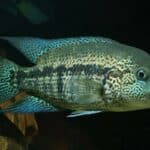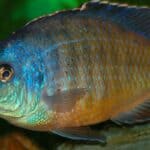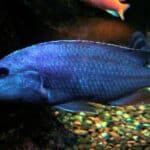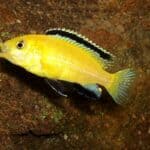Severum cichlids are one of the most active and easy-to-maintain pet fish today. They belong to the genus Heros.
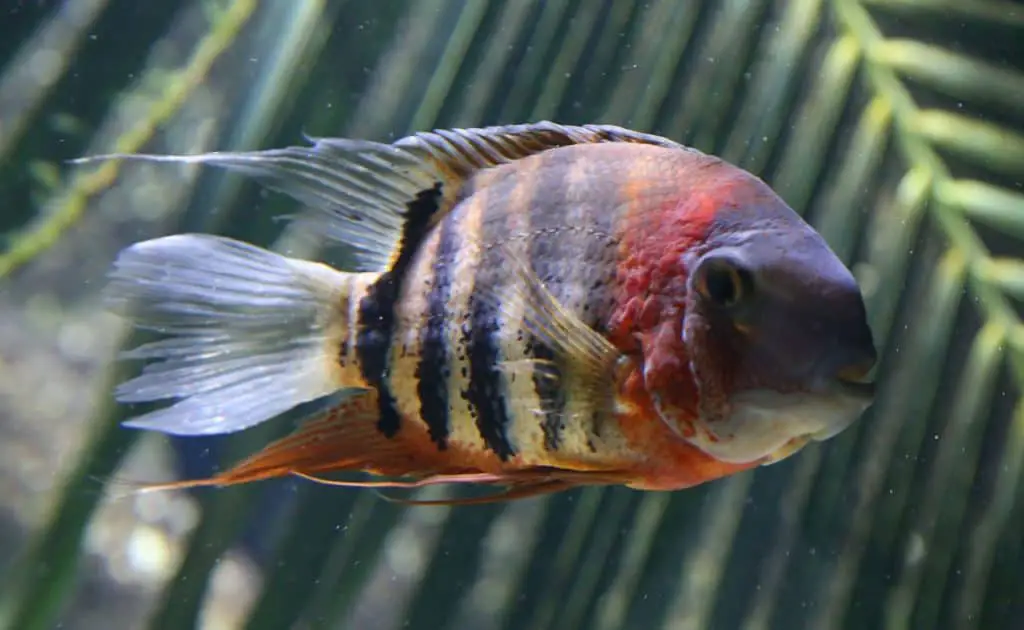
Severum cichlids, a freshwater fish endemic to the northern river basins of South America from Brazil to Peru, live mainly in the Amazon, Ezekibo and Orinoco rivers of South America.
In this article, we will consider how to keep this beautiful active pet fish happy at home.
Care Guide
Tank Size
When you set up the tank for the severum cichlid, the most important thing to consider is to give them enough space. A tank of about 75 gallons is recommended for a minimum of two severum cichlids. The aim is to provide such an environment in our homes for those living freely in the South American river basins. Giving them enough space reduces their stress and allows them to stay healthy and more active.
Tank Setup
Please make sure to fix the following points when setting up a tank for a severum cichlid,
- Substrate type: They are very fond of sand substrate. So add a predominantly sand substrate instead of substrates like stones and gravel.
- Lighting: Since the severum cichlid prefers darkness, make sure to provide minimal light to the tank you are setting up.
- Temperature: The temperature of the tank should be between is 75 – 85℉.
- pH level: The pH level of the tank water should be maintained between 6.0-6.5. Changes in pH level can stress the fish and can even destroy them. Proper maintenance and water change of the tank should be done once a week.
- Brackish: Recommended hardness range of the water is 4 – 15 dGH. Accordingly, adding a little saltwater to your tank will not cause any harm to the fish.
- Water Movement: Keep a moderate flow of water in the tank set up for them.
- Tank Decoration: You can add flat rocks or round rocks to the bottom of the tank and use artificial plants and stones to decorate the tank.
Tankmates
Severum cichlid is a community fish. Accordingly, they can live in peace with other species. What makes them unique is that they are not like other cichlids and show less aggression. However, they need to be given adequate space so that they are not disturbed by others.
It is also important to select fish that have a habit of living in the same water parameter when selecting mates.
Below are some of the species that are best suited for the severum cichlid. It will give you an idea of how to choose a tank partner.
- Blood parrot cichlid
- Pearl cichlid
- Flag cichlid
- Loaches
- Large characins (eg. silver dollar fish, etc.)
- Angelfish
- Black skirt tetra
- Gouramis
- Sharks (eg.Redtail black shark, etc.)
- Blue Acara
- Catfish species
- Barbs (eg. Tiger barb)
Care should be taken not to add aggressive fish here. However, you have to check them constantly if you want to keep the severum cichlid with invasive, semi-invasive, large invasive or predatory fish.
Tank partners to avoid: Large fish in size and highly invasive fish are unsuitable for addition with severum cichlid.
Also, species such as small fish, shrimp, snails and crabs should not be allowed to live with them, as they would become severum cichlid’s food.
Common Diseases
Like most fish, your severum cichlid can get sick. It can also be caused by poor hygiene, diet, overeating, poor water quality, etc.
So let’s find out what diseases they get.
Head and Lateral Line Erosion (HLLE)
It is most common in fish kept in tanks with poor water conditions. Severum cichlid suffering from this disease often show pits or itching on their head and faces.
Factors such as poor hygiene, activated carbon, poor diet, and vitamin deficiency can cause this disease.
Treatment: Immediately isolate the infected fish and adjust the aquarium condition to the required standard.
Also, make sure you have a good nutritious meal. A diet rich in vitamins C, D, phosphorus and calcium is recommended.
Ich
The disease causes damage to the skin and fins of fish. In addition, a parasite such as mites, can be seen on the head and body of the fish. It is a contagious disease.
Treatments: The treatments used for this purpose contain large amounts of copper, an effective active ingredient against this parasite.
Isolate diseased fish.
Take Aquari-sol, copper, malachite green, etc., in the right proportions and treat them.
Be sure to remove all carbon filters from the tank to prevent activated carbon poisoning.
Swim Bladder Disease
Severum cichlid has problems staying underwater. Thus, they can show floating and other strange swimming patterns.
Damage causes infections to the swimming bladder of the fish. In addition, they can be affected by diseases such as physical trauma, poor nutrition, and cancer.
Treatment: It is not easy to treat, and it is essential to identify early. If it is caused by malnourishment, make sure to provide a nutritious meal for those fish.
Please take the following actions to prevent these common diseases.
- Buy only high-quality fish
- Quarantine before putting in the tank
- Avoid straining the fish.
- Select only suitable fish species.
- Do not overfeed
- If the disease is prevalent, quarantine the affected fish and disinfect the nets used to remove them.
- Do not transfer water from the quarantine tank to the main tank.
Food and Diet
Severum cichlid is an omnivore. Accordingly, these foods can be given to them: Pellets, flakes, earthworms, blood worms, mealworms, marine crustaceans, white mosquito larvae, vitamin enriched brine shrimp, krill, mysis, chopped prawns, green vegetables, shelled frozen peas, dried spirulina, and blanched spinach.
Be sure not to give liver or beef heart because it is difficult to digest.
It is advisable to give small portions of meals 3-4 times a day. It also helps to avoid consuming large amounts of food at once.
Lifespan
On average, severum cichlids live for about five years. However, they will stay with you for ten years with proper nutrition, love, optimal environment and care.
Appearance
The unique body and golden color are the main distinguishing features of the Severum cichlid. They have pointed anal and dorsal fins that are yellow. Their tails have a white base colouring with a speck of yellow on them; their eyes are also yellow. The fries have uniformly gold colours that become speckled with orange spots across a large part of their body and fins as it matures.
There are different types of Severum cichlid:
- The deacon severum is green in colour, with brown lines running down its entire length.
- The golden severum has a plain gold colour that is sometimes peppered with dark stripes down its length.
- The red-spotted golden severum, has a gold base colour with beautiful red dots over all its body.
Male vs Female
In male severum, cichlids are big and have markings on their gills.
The male severum cichlid may normally develop a nuchal hump and extensions to its anal and dorsal fins. In addition, the length of its dorsal and anal fin gives them a more pointed appearance.
Female severum cichlid can be recognized by the telltale dark spot on her dorsal fin plus the lack of patterning on her top.
Size
Severum cichlid fish can grow as big as 8 inches with proper care and nutrition.
Behaviour and Temperament
They are very peaceful by nature. However, they can be aggressive during the mating process.
They live very peacefully when provided with ample space and suitable tank mates in the aquarium tank.
Breeding
The severum cichlid tank for breeding should be set separately, where the temperature should be slightly higher. It should be between 78.8 and 80.6. Also, the acidity of the water should not be less than pH 6. Also, the hardness of the water should be maintained at 50 ppm.
Also, even if sand is placed on the tank’s substrate, flat stones or large rocks should be put at the bottom of the tank for the female to lay her eggs. For this, you can also put artificial plants and stones in the tank.
Pairs used for breeding should be provided with a good diet rich in live nutrients.
Couples of severum cichlid are seen kissing each other as they prepare for mating. In males, the colour of their scales intensifies during mating. They also wag their tails at each other.
The female can lay thousands of eggs fertilized by a male. Eggs hatch in 3 days. Once the eggs are hatched, the parents’ severum cichlid take them into their mouths; they are mouth breeders. Then, the parent severum cichlid protects their fries for about six weeks until they are ready to live alone.
Fun Facts
Severum cichlid communicates by vision, scent, electrical impulse, and sound. Communication helps them to navigate within the water as well as during reproduction.
The Severum cichlid species is a big fan of free-swimming. They require large tanks with enough space for free swimming.
A severum weighs around 3.5 oz (0.1 kg).
A baby severum is called a ‘fry,’ just like other fish species.
Severum fish have a pharyngeal set of teeth present in their throat along with their usual set of teeth.
There are five known species of the severum family. They are:
- Heros severus
- Heros efasciatus
- Heros liberifer
- Heros notatus
- Heros spurius
The Heros severus is the most common severum. Some types of severum are also bred and produced in captivity.
They are available in different colour breeds, and some of the most common severum species are the gold severum, the green severum, and the red severum.
References
Fish, B. T., & Fish, B. T. (2021, June 4). Severum Cichlid: A Beginners Guide to Raise This Fish. Badman’s Tropical Fish. https://badmanstropicalfish.com/severum-cichlid/
Dubey, A. (2021, May 6). Severum Cichlid Care Guide: Tank Setup and much more – 2021. Fish In Aquarium. https://fishinaquarium.com/severum-cichlid/#Interesting_Facts_About_Severum_Cichlid



